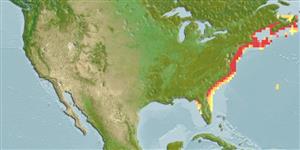分類 / Names
共通名の | 類義語 | Catalog of Fishes(部類, 種) | ITIS | CoL | WoRMS | Cloffa
>
Clupeiformes (Herrings) >
Alosidae (Shads and Sardines)
Etymology: Alosa: Latin, alausa = a fish cited by Ausonius and Latin, halec = pickle, dealing with the Greek word hals = salt; it is also the old Saxon name for shad = "alli" ; 1591 (Ref. 45335).
More on author: Mitchill.
Environment: milieu / climate zone / depth range / distribution range
生態学
海; 新鮮な水; 汽水性の; 昇流魚 (Ref. 51243); 深さの範囲 5 - 55 m (Ref. 5951). Subtropical; 47°N - 27°N, 84°W - 60°W (Ref. 117456)
Western Atlantic: Cape Breton, Nova Scotia south to the St. John's River, Florida; also in lower parts of rivers (Ref. 188). Introduced in reservoirs in several states, and in the upper Tennessee River system in Tennessee, USA (Ref. 117456, 86798).
サイズ / 重さ / 年齢
Maturity: Lm ? range ? - ? cm
Max length : 40.0 cm SL オス/雌雄の選別がない; (Ref. 7251); common length : 27.5 cm SL オス/雌雄の選別がない; (Ref. 188); 最大公表体重: 200.00 g (Ref. 7251); 最大記録サイズ: 8 年 (Ref. 12193)
背面の脊椎 (合計): 0; 背鰭 (合計): 15-20; 肛門の骨 0; 臀鰭: 15 - 21; 脊つい: 47 - 53. Moderately compressed, belly with distinct keel of scutes. Upper jaw with a distinct notch; lower jaw rising steeply within mouth; minute teeth present at front of jaws (disappearing with age). Lower gill rakers 41 to 52 (fewer in fishes under 10 cm standard length), slender. Back dark blue, sometimes bluish-grey; a dark spot on shoulder (Ref. 188). Peritoneum black (Ref. 7251). Branchiostegal rays 7 (Ref. 4639).
Inhabits rivers, estuaries, coastal waters, lakes and reservoirs (Ref. 117456). Adults are found in saltwater except during the spawning season and occur up to at least 200 km offshore (Ref. 117456). Forms schools and possibly wintering near the bottom and out from the coast, approaching the shore in the late spring. Feeds on small fishes, copepods and small shrimps. Spawns in brackish- or freshwaters of rivers, arriving in coastal waters a month or so later than A. pseudoharengus (in April at Chesapeake Bay, apparently when the water is above 7.0° C and later further north). Eggs are essentially pelagic, demersal in still water (Ref. 4639). Larvae are found in fresh and brackish rivers (Ref. 4639). Juveniles leave fresh and brackish nursery grounds at about 5 cm, migrating downstream (Ref. 4639). In freshwater habitat, this species usually occurs in current over rocky bottom (Ref. 86798). Marketed mostly fresh and salted (Ref. 188). Parasites found are acanthocephalan and nematodes (Ref. 37032).
Life cycle and mating behavior
成熟 | 繁殖 | 放精 | 卵 | 生産力 | 幼生
Upriver movement to spawning areas occur in late afternoon or at night (Ref. 4639).
Whitehead, P.J.P., 1985. FAO Species Catalogue. Vol. 7. Clupeoid fishes of the world (suborder Clupeoidei). An annotated and illustrated catalogue of the herrings, sardines, pilchards, sprats, shads, anchovies and wolf-herrings. FAO Fish. Synop. 125(7/1):1-303. Rome: FAO. (Ref. 188)
Human uses
水産業: 商業
より多くの情報
協力者画像Stamps, Coins Misc.音シガテラ(食中毒の名前)速度泳ぐ 型式カマOtoliths脳視覚
用具
特記事項
XMLをダウンロードして下さい
インターネットの情報源
Estimates based on models
Preferred temperature (Ref.
123201): 11.5 - 24.7, mean 23.7 °C (based on 86 cells).
Phylogenetic diversity index (Ref.
82804): PD
50 = 0.5000 [Uniqueness, from 0.5 = low to 2.0 = high].
Bayesian length-weight: a=0.00794 (0.00370 - 0.01703), b=3.04 (2.87 - 3.21), in cm total length, based on LWR estimates for this Genus-body shape (Ref.
93245).
栄養段階 (Ref.
69278): 3.8 ±0.3 se; based on diet studies.
回復力 (Ref.
120179): 手段, 1.4年~4.4年の倍増期間の最小個体群 (K=0.18; tm=4; Fec=45,800).
Fishing Vulnerability (Ref.
59153): Moderate vulnerability (39 of 100).
Climate Vulnerability (Ref.
125649): Moderate to high vulnerability (50 of 100).
Nutrients (Ref.
124155): Calcium = 28.1 [13.7, 137.6] mg/100g; Iron = 1.47 [0.63, 3.85] mg/100g; Protein = 19.8 [17.4, 22.6] %; Omega3 = 0.744 [0.386, 1.503] g/100g; Selenium = 18 [9, 36] μg/100g; VitaminA = 18.7 [4.7, 78.7] μg/100g; Zinc = 0.505 [0.325, 0.920] mg/100g (wet weight);
